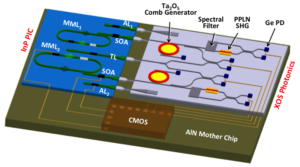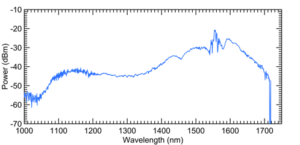Researchers: Jean-Etienne Tremblay, Yung-Hsiang (Jacky) Lin
Funding Agency: DARPA

Figure 1: DODOS platform overview. The InP PIC will host the tunable laser and the mode locked laser. The XOS photonics chip integrates nonlinear materials (such as Ta2O5, GeSbS or lithium-niobate) with Ge photodiodes. The optical components as well as the CMOS electronics will be assembled on an AlN mother chip.
Following the invention of optical frequency comb metrology, for which a Nobel Prize was awarded in 2005, supercontinuum light sources have found a diverse range of applications such as spectroscopy and optical coherence tomography. Self-referenced frequency combs generated from femtosecond pulses in highly-nonlinear fibers have led to optical synthesizers with record breaking stability and accuracy. The recent interest in low-power, highly integrated frequency comb sources has motivated the research to fabricate frequency comb devices using techniques compatible with microfabrication. Supercontinuum have now be demonstrated in material platforms suitable for chip-scale integration such as silicon nitride.

Figure 2: Supercontinuum generation in a 2cm long GeSbS waveguide. 500fs pulses are amplified in a EDFA up to an average power less than 10mW.
We investigate the use of promising materials that show even higher Kerr nonlinearity, such as Ta2O5 and chalcogenides glasses (ChG). ChG materials such as GeSbS have a Kerr nonlinearity more than 3x larger than silicon nitride and show low optical losses in the infrared region. We have demonstrated GeSbS waveguides with a low propagation loss of 0.2dB/cm. Supercontinuum were generated in 2cm long GeSbS waveguides with a pulse energy of 120pJ, showing that octave-spanning spectrum will be possible with low input power.
